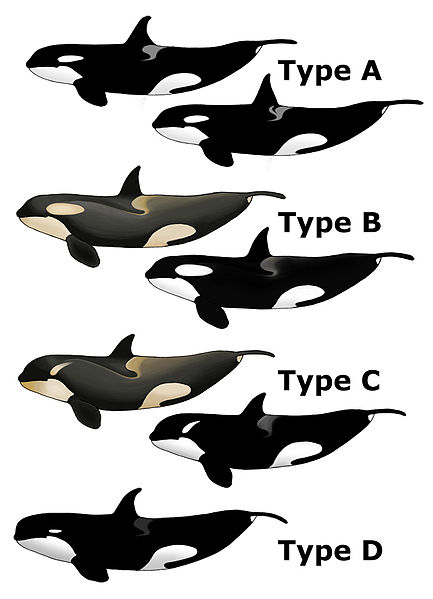Hunting Behavior in type a and type b Orcas
Biology 342 Fall 2014
MAMMAL-EATING KILLER WHALES

Fig 1. Orca ecotypes of the around Antarctica.
Figure 2. Type B Killer whales engaging in wave washing. Note the spy-hopping in order to locate the seal on the ice.
Killer whales (Orcinus orca) range global waters as a top predator due to their ability to adapt their hunting and social behavior to prey species availability. The range and dietary specialization of groups of killer whales results in several ecotypes, or “...groups of individuals with similar ecological adaptations…” (De Bruyn et. al., 2013); these ecotypes do not interbreed and may be on their way to speciation (De Bruyn et. al., 2013). The killer whale ecotypes are differentiated by their specialization in hunting mammals or non-mammals, and by the separation between Northern and Southern Hemispheres and Atlantic and Pacific Oceans (De Bruyn et. al., 2013). In Antarctica, there are tenatively 4 known ecotypes (see figure 1) (De Bruyn et. al., 2013).
Type B killer whales, also known as “Pack Ice Killer Whales”, live in Antarctic waters and feed exclusively on seals. In order to catch seals who have hauled out on ice floes, Pack Ice Killer Whales engage in a dramatic cooperative hunting behavior known as wave-washing. After locating seals on ice floes by spy-hopping (“lifting their heads vertically out of the water in order to view things on the surface” Pitman & Durban, 2012), they swim together in a V-formation toward the floe in order to create a wave to wash over the floe and throw the seal into the water where it can be captured and subsequently pulled down by its hind flippers and drowned (Pitman & Durban, 2012). An example of such behavior can be observed in figure 2.
Figure 3. Type A Killer whales grabbing seals on-shore by self-stranding.
Type A killer whales live around Antarctica where they hunt other cetaceans and seals (De Bruyn et. al., 2013). They engage in a dramatic behavior of stranding themselves on shore in order to grab seals and pull them back into the water.
This website uses the categories laid our in Tinbergen's 1964 paper to explore these two dramatic hunting behaviors seen in mammal-hunting killer whales in Antarctic waters. First we explore the evolutionary basis of the behavior, or phylogeny, next we explore the physiological means which make killer whales capable of complex and cooperative hunting behavior in the mechanism section, thirdly we look at how the behavior increases the animals fitness in the adaptive value section, and lastly we look at the development of the behavior over the animals lifetime, or ontogeny.
Website by Cecelia Erwin and Orian Evans for Reed College Biology 342: Animal Behavior.
Website design, content, research by Cecelia Erwin.
Content by Orian Evans.






